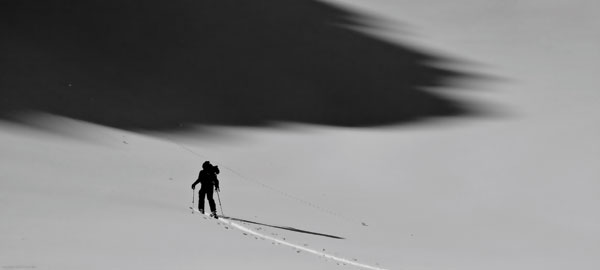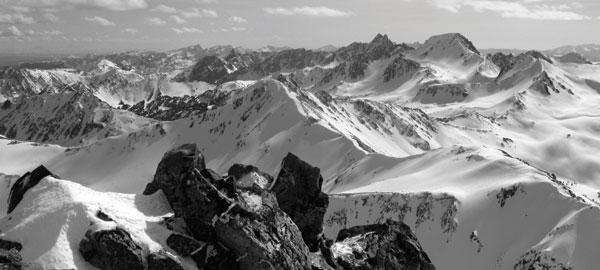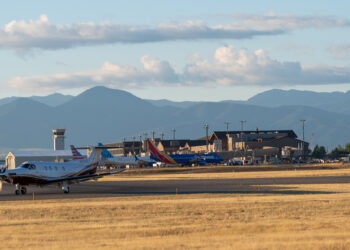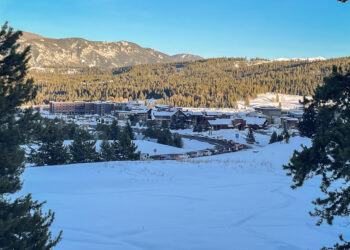Earning a skier’s right of passage in the Madison Range
by Taylor Woodward
Photos by Luke Rice
The ridge seemed to go forever. Weaving past giant cornices, we skinned higher until snow gave way to rock under a prominent summit. I felt relieved when, ahead of me, Ryan Kapes stopped moving.
“This is it,” he said. “Check out that east couloir!” Mount Dudley holds a handful of skiable lines, only obvious when viewed from Dudley Creek to the east. From the beginning, Kapes had a plan. I had just met him a few weeks ago, but today he promised powder skiing off the top of Dudley. He rattled off peaks in the surrounding area. “That’s Wilson across the way, and there’s Jumbo and Gallatin Peak—you gotta ski the Southeast face of Gallatin.”

“What’s with that range to the south?” I asked.
“That’s still the Madisons. The big stuff.”
These mountains seemed to hold endless possibilities for adventure. I shook myself from a stupor, remembering going down was pertinent. We skied deliberately, leaving deep turns to the valley floor as the high country lingered in the evening. I wondered why it took me so long to move here. My excitement became insatiable.
Moving from a temporary existence in Boulder, Colorado to Big Sky a month earlier, in January 2006, couldn’t have come at a better time for me. I’d been stagnating in the big city and felt like I was in a rut. I packed my ski gear and everything else that fit into my 1984 Honda Civic, and then headed north, puttering up dark state highways. I’d scored a job as a ski patroller at Moonlight Basin and moved there mid-season.
A week after our Dudley tour, Kapes and I went to Beehive Basin, Big Sky’s best access into the Spanish Peaks’ high alpine zones. Kapes talked as we skinned over a ridge toward Bear Basin. “You can’t just go anywhere you want,” he advised. “This isn’t Mount Baker. The snow here is different from Washington, and we’re way back here.”
Excited and perplexed, I appreciated Kapes’ continuous tidbits of advice. He pointed out Bear Basin’s prominent ski lines: The Hoo Haas, Bat Ears, The Giver and other obscure gems spilling towards Spanish Creek. No matter the punchy conditions, we had the place to ourselves.
“That pass takes you to Hellroaring Creek.” Kapes pointed. “The other one leads into Spanish Creek.” The names were familiar from highway signposts, but I had no idea how big the drainages really were. How far back could we ski in a day? This question only fueled my fire.

I was determined to know everything about the Spanish Peaks. Every day off from work, I went back for more. On each outing, I found new terrain. Couloirs, traverses, open bowls and white bark tree runs satisfied my powder craze. Then, later in the spring, while skiing Beehive’s tight, steep and rocky lines, I discovered Montana ski mountaineering.
The Madison Range is a sizeable and relatively unbroken span of wilderness in Southwest Montana. Running north to south from the Gallatin Valley to Hebgen Lake, these mountains span over 50 miles, and boast some of Montana’s highest continuous alpine terrain, writes Thomas Turiano in 50 Select Peaks of the Greater Yellowstone. After nearly a century of exploitation between government land swaps, railroad misuse and logging blunders in this spectacular area, Montana Congressman Lee Metcalf proposed a wilderness area of over 600,000 acres in the 1970s. A conflicting bill by Sentator John Melcher won however, appeasing recreation interests and logging industry giants. In 1983, Congress protected 261,000 acres in the Lee Metcalf Wilderness.
For sake of explanation, the range can be split into three sections: the Spanish Peaks, the West Fork Peaks and the Taylor-Hilgards. Big Sky Resort and the surrounding community—which split the northern and southern half of the wilderness—exemplify land use compromises introduced by Melcher’s bill.
Jack Creek and the Middle Fork of the Gallatin River isolate the Spanish Peaks as the northernmost part of the Madisons. Northwest weather patterns rising out of the Madison River Valley favor these mountains, and as a result, they receive similar snowfall as nearby Big Sky. The rock here, 1.6 billion year old gneiss, began crystallizing during the Precambrian Age and has eroded away to sculpt buttresses, fins and walls. In turn, these rock formations give way to clean couloirs and featured summits. At over 8,000 feet, Beehive Basin provides ski access into this area from early October turns to late-season mega tours deep into the backcountry.
South of Sphinx Mountain, a geological division line called a thrust fault separates the northern section of the Madisons from the Taylor-Hilgards. The area between holds the West Fork Peaks: Cedar, Lone Peak (home to Big Sky and Moonlight Basin), Pioneer (Yellowstone Club) and Fan Mountains. These dramatic massifs are anomalies, formed independently into masses of folded sandstone, limestone and shale. About 70 million years ago, magma worked its way into sedimentary formations leaving dacite porphyry, which bears a mistaken resemblance to volcanoes of the Cascade Range. Cedar and Fan are visible from the ski resorts on Lone Peak and the Yellowstone Club, but backcountry ski objectives on those mountains are large-scale and remote, with difficult access due to private land.

The Taylor-Hilgard mountains make up the southern half of the greater Madison Range. In 1959, a 7.3 magnitude earthquake here caused a massive landslide that killed 28 people and blocked the Madison River, creating Quake Lake. Geologically, the Hilgards consist of three billion year old metamorphic rock, massive glacial moraines and lofty rock horns. This remote sub-range runs about 25 miles north-south and has limited winter access due to long and difficult approaches. The allure to skiing here is the concentration of 11,000-foot peaks like Koch, Imp, Echo and Hilgard. At 11,316 feet, Hilgard Peak stands proud as the highest point in Montana outside the Beartooth Range.
We lifted our feet unloading the Headwaters chairlift, plowing through giant drifts on our way to morning avalanche control work in Moonlight Basin’s alpine terrain. It was March 2008, and we’d received two feet of snow overnight. After 18 inches the previous day, Lone Peak’s alpine terrain was powder heaven. I wallowed up Country Club in disbelief of the waist deep snow. Switching leads with other ski patrollers, we broke trail in a fitful fashion. En route to Three Forks, we skirted the start zones of the chutes Firehole, Hellroaring and Jack Creek, which were choked with snow.
“Hurry up! We gotta open soon!” Matt Weiland, my route partner, prodded and chastised me for breaking trail so slowly.
“You try. I’ll hang back and bother you,” I said. My agitation felt bittersweet.
Wieland sunk to his neck, flailing. As we rested at the top of Rock Creek, the sun breached the horizon behind Ramshorn Peak and grazed the highest peaks around us with a fiery hue. South, in the Hilgards, Imp Peak ignited in flames of red.
Every detail of Lone Peak consumed me as if I’d never seen the mountain before. Kapes and Weiland stood beside me as the day unveiled, broken by the infantry of Moonlight Basin ski patrol.
Part of a coordinated siege of the Headwaters cirque, Weiland and I moved down Three Forks, throwing explosives, ski cutting and watching each other from safe spots. We communicated with patrollers in neighboring chutes, because staying away from their avalanche run-outs was essential. My radio crackled continuously, as patrollers called in shots. “Fire in the hole!” Explosives broke through the cold morning air.
Fire on Lone Peak, I thought, watching the sunrise fade into memory.

March 2009 5:00 a.m. Two degrees Fahrenheit couldn’t convince my frozen fingers to hitch the snowmobile trailer. We grabbed coffee and junk food at the Conoco, fuel for a big push up Imp Peak in the Hilgards. It was still dark as we pulled onto 191 South. In the moonlight I saw the Gallatin River, locked in icy grips.
The weather was clear and cold, with no storms predicted for days. The truck hopped between ruts down the Taylor Fork road. We parked at the ranch and began blindly foraging for gear in the darkness.
“This is going to be a cold ride for you,” Kapes said. “Enjoy it.” He preferred to tow me behind his snowmobile rather than destroy his suspension by riding tandem.
We counted six moose in the creek, stoically posed in willow groves. As we closed in on the trailhead, Woodward Peak caught the sunrise above us through low clouds. We left the snowmobile and made good time skinning up the drainage on supportable crust. Barely speaking a word the first four miles, we moved upwards through the cold morning.
We took a break at the first sunny spot along the creek. I looked back at the crazy rock striations of Woodward Peak and thought of my friend Troy, who had told me about that mountain. “Some day you’ll ski your namesake!” he’d said. I’d taken his advice in fall of 2007, climbing and skiing Woodward’s north couloir above the Taylor Fork.
When we reached the elevation where White Bark pines gave way to meadows, a castle-like peak grazed the horizon. Another north couloir split the gothic rock horns on Imp Peak’s north face for 2,000 vertical feet. We wove through an endless maze of terminal moraine, ending the nine-mile approach.
“The wind beat us to it,” I said, looking up at the scalloped and drifted snow on Imp’s north face. The slope above had taken a beating and was stripped of recent new snow.
We booted up toward the notch below Imp’s summit and arrived at the ridge. Goats scattered from the knife-edge in a frenzy. To the south, the Henrys Lake Mountains snaked toward Island Park. Beyond that, we could see the Tetons. The Gravelly, Centennial and Pintler ranges wandered west in the distance. To the east, the Gallatins and Absarokas. North, the spine of the Madisons continued unobstructed until spilling out of sight into the Gallatin Valley.
“I just found the next twenty years of my life,” I said.
Kapes agreed with a casual smile, as he stripped the climbing skins from his skis. “Let’s go skiing,” he said.

Mountains mean something different to each person. For me, skiing is an outlet. It is my way of life and a tool of exploration. I find freedom one summit at a time—meeting a sunrise or finding a white bark tree alley that unfolds in front of every ski turn. In Montana, I’ve found unnamed couloirs, mountain traverses I dream to complete, and salvation in perfect powder days. The will for adventure keeps me human. I wouldn’t trade it for the world.












